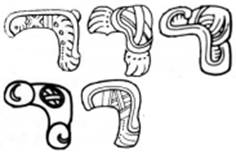


![]()
![]()
K&L.p28.#8 TOK.p34.r5.c3 BMM9.p20.r4.c2 JM.p142.#3 AT-E1168-lecture11.t0:07:21
PMT Jade Pendent
K’ABA’ K’ABA’ K’ABA K’ABA u.K’ABA’

![]()
25EMC.pdfp39.#5.2 25EMC.pdfp39.#5.3 25EMC.pdfp39.#5.1 = JM.p142.#3 25EMC.pdfp39.#5.4 = K&L.p28.#8.1
K’ABA’ K’ABA’

![]()
![]()
![]()
AT-E1168-lecture15.t0:01:48 AT-E1168-lecture15.t0:02:23 AT-E1168-lecture15.t0:03:26 AT-E1168-lecture15.t0:12:13
CPN Stela 6 YAX Lintel 56 G2b PNG Strucfture K-5 Name Stone
K’ABA’ u+K’ABA’ u:K’ABA’ u.K’ABA’

![]()


AT-E1168-lecture15.t0:05:04 AT-E1168-lecture15.t0:05:34 AT-E1168-lecture15.t0:06:57 AT-E1168-lecture15.t0:07:25
Xkalumkin Lintel 1 K1 & O1 K7460 QRG Stela E PAL Palace Tablet
u+K’ABA’.a [u]K’ABA’.a u.K’ABA’ u.<<ch’o:ko>+K’ABA’> K’ABA’+a

Graham
YAX Lintel 31 K1a
u:K’ABA’:a
· No glyphs given in K&H.
· K&L, TOK, 25EMC give K’ABA’ (final glottal stop) but BMM9 and JM give only K’ABA (no final glottal stop):
o JM: could be old reading, superseded by K’ABA’ nowadays.
o BMM9: could be a typo, as the consensus nowadays is K’ABA’.
· Features:
o An L-shaped glyph – an uppercase L rotated 180 degrees, and with approximately equal-length legs.
o At the “corner” of the L, a bold circle, with crossed bands inside.
o (Optionally, but quite commonly): on the inside of the ends of the legs of the L: a series of parallel ticks, each ending in a dot. The ticks run parallel to the axis of the leg itself which they appear in:
§ There can be no ticks at all (in which case there are also no dots), or
§ There can be ticks (with no dots), or
§ There can be ticks and dots.
· Dorota Bojkowska agrees that there is doubt about whether to read this as K’UH; maybe the whole logogram, including the K’UH is K’ABA’, and we can have infixed CH’OK (obscuring the K’UH); but FK2.pdfp4.r1.c5 shows two readings, one with embraced K’UH, and one with embraced CH’OK – need to ask someone (in particular Felix).
· AT-E1168-lecture15 has many examples – the general pattern seems to be that:
o The K’UH or head variant of LEM has no pronunciation, and is part of the logogram.
o Only when the K’UH or head variant of LEM is covered by an infixed ch’ok does it get read as ch’ok k’aba’.
· Quite a number of examples have an a attached to the K’ABA’, indicating that it ends in a glottal stop.
· Very superficially, K’ABA’ can be mistaken for the abstract variant of CHUWEEN because they both have the “reflected-and-rotated-L” shape. However:
o K’ABA’ has crossed bands at the midpoint of the “L”, whereas CHUWEEN has “struts”.
o The ends of the “L” of K’ABA’ don’t “curl around” (and have a series of ticks), whereas the ends of the “L” of CHUWEEN “curl around” slightly (and have no ticks).
o The “L” of K’ABA’ embraces a K’UH or ch’ok, whereas the “L” of CHUWEEN embraces a se.
· Compounds:
o ch’ok k’aba’: childhood name, youthful name.
o k’aba’ tuunil: “name stone”, funerary tablet, “tombstone”.
o k’al huunil k’aba’: accession name, coronation name.
o yet k’aba’il: namesake.
![]()
AT-E1168-lecture15.t0:04:38
CHN Casa Colorado Lintel
u.<k’a:<ba:K’UH>>